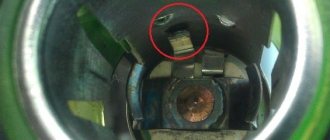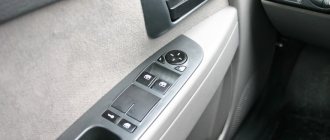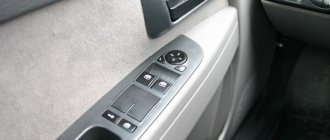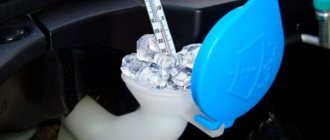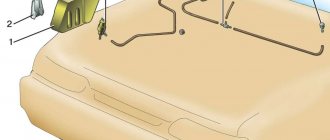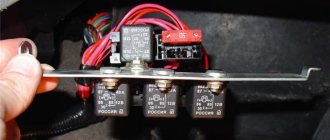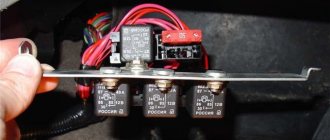If a problem with the window regulator on a VAZ-2114 occurs while the car is moving, and the driver himself cannot correct the situation on the spot, you need to call a tow truck. The movement of a car when the window has stopped going up or down due to a breakdown, from the point of view of traffic regulations, threatens the safety of passengers and the driver himself. Why does the VAZ-2114 window lifter not work? There are many reasons: lowering is difficult because the fuse has blown, there is a malfunction in the door, etc. This article contains information about the types of failures of window regulators on the VAZ-2114, about methods for adjusting and dismantling the mechanism.
Device classification
Window lifters on the VAZ-2114 are standard for other models of the Samara series. They are classified by drive type into:
- mechanical;
- electric.
The latter are divided depending on the method of transmission of the motor impulse:
- lever;
- rack and pinion;
- cable
By type of construction:
- collapsible;
- whole.
Each model has its own advantages, disadvantages and price. Standard configurations of window lifting mechanisms on the VAZ-2114 consist of two types. Electric drive mechanisms are installed in front, while the rear doors are equipped with mechanical devices.
The most common reasons why the VAZ-2114 window regulator does not work
There is no point in arguing that power windows significantly increase the operating comfort of a car. But most drivers also know that they cause a lot of trouble. By the way, when it comes to the breakdown of the mechanism, we must not forget that the problem may not be in it, but in the glass itself. Over time, the holder or seals wear out, which often leads to a banal misalignment, which significantly impedes the freedom of movement of the glass.
The design of the window lifting mechanism is quite simple, but not reliable. And the fact that the safety block is placed in a place where moisture and dirt can easily get in is also not a plus. As you know, the slightest wear of the insulation can lead to a short circuit and breakdown of the entire system.
The most common reasons why a window regulator fails are the following:
- Damage to the components of the control unit.
- The contacts have oxidized and the circuit has opened.
- Disconnecting the power supply.
- The control button has stopped performing its functions.
Yes, most often car enthusiasts are faced with the fact that this component of the window regulator fails.
Common faults
One of the most common malfunctions is gear wear. Usually plastic is used, which wears out quickly over time. A symptom of this problem is a rumble and crackling sound that is heard when the glass is raised or lowered.
Also, the automatic switch on the power windows may burn out, which is why the inclusion will not work. Also, problems may arise with the rear doors. They either stop working altogether or respond to pressing a key from the main unit, but not on the doors themselves. Check current continuity.
The electric motor may also fail. To fix it, you will need to check the voltage in it and the wiring. Mechanical damage to the guides may also occur.
Broken power window button
Why does the VAZ-2114 window lifter not work? A very common reason for this is that its buttons fail. If the mechanism begins to work at a slow speed after a certain time, the plates inside it may have oxidized. This caused a breakdown in contact: it appears intermittently or disappears completely.
It makes sense to check the version with a broken button, replacing it with a working one. Just swap them. The part is dismantled using a knife or screwdriver. Use the tip to pry it from below and remove it from the chip.
If after installation it turns out that the non-working window regulator began to move the glass, and the working one began to move, on the contrary, then it is worth purchasing a new part and replacing it. If the problem is not with the button, then you need to continue searching for the causes of the breakdown.
Malfunction in the fuse box
One of the reasons why the window regulator on a VAZ 2114 does not work is a problem with the mounting block. Open the cover of the block and, using the drawing printed on it, determine the location of the fuse of interest. Assess the condition of the fuse insert through which the window regulators are powered. If it is intact, check the relay.
Inspect the condition of the relay legs and fuse. There should be no plaque on them. If available, use WD-40, but it is better to dismantle the unit completely and, only after that, clean it. The presence of plaque is evidence of moisture getting inside, which leads to a deterioration in the conductivity of contacts.
To test the relay, install a known-good device of the same type in its place. For example, you can take the relay through which the high beam headlight is powered. If, after rearranging, the power windows start to work, throw away the failed relay, buy and install a new part.
If checking the fuse shows that it has burned out, replace the part and check the operation of the power windows. If the mechanism starts working, the problem is solved. On domestic VAZ cars, there are situations when fuses burn out for no reason.
It’s worse if you installed a new fuse-link and it immediately burned out. This indicates a short circuit in the circuit. The reason may be a broken wire or damaged insulation, due to which the “plus” gets to the ground of the machine. In this case, it is better to entrust the solution to experienced auto electricians.
Relay
One of the reasons for the breakdown of the glass door lift mechanism may be that the relay does not work or the fuse has blown.
- Find the safety block under the hood of the car.
- According to the diagram, determine the location of the relay itself and the fuse, which make up the links of the electric glass lifting mechanism (ESM) chain.
- The legs of the elements must be clean, with a pronounced metallic sheen.
- If traces of oxidation, dirt deposits, etc. are found, you need to clean them off. Mechanically or using special means, for example, WD-40.
- You can check the relay for functionality in the same way as a button. The working element should be removed from another unit and mounted into the ESP system.
- If newly installed parts fail again within a short period of time, then the problem is in the wiring itself.
A breakdown may occur with the lift motor. It either burns out completely, or the worm mechanism inside it fails. In the latter case, the device makes a characteristic sound when the button is pressed, but the glass remains motionless.
The reason for the breakdown of the ESP may be that it has a common power source and the external lighting. And if the fuse for the foglights is blown out, the window regulator will not work.
Why does the window regulator work poorly?
- The first reason is poor lubrication of the window lift mechanism. During operation, the ESP mechanism gradually loses lubrication, causing the windows to slowly lower or rise. The solution to the problem is to remove the door card, after which all working parts are lubricated. If after lubrication of the window lifter mechanism the problem is not eliminated, we continue to search for it.
- Often the reason may be poor adjustment of the glass itself. That is, a situation where the glass itself is not installed correctly on the lifting bar. In this case, it is necessary to remove the door card and adjust the position of the glass using the adjusting nut, and then check the operation of the ESP.
- Factory defect. If everything is ok with the mechanism and the glass is in place as it should, I advise you to check the guides along which the glass itself moves. That is, we are talking about a tunnel in which glass flows. As bitter experience shows, it is this manufacturing defect that often becomes the reason why the window lifter slowly raises. Due to the narrowing of the guides, additional resistance occurs, as a result of which the motor slows down and the glass slows down. Your task is to understand exactly where the resistance arises and try to correct it. The work is quite simple and consists of removing the velvets and slightly expanding the narrowing area of the metal.
- The fourth reason is poor lubrication of the guides. Sometimes, during operation, the guides, or it would be more correct to say the tunnel along which the glass moves, wear out, become abraded, become dirty, etc. As a result, the glass experiences excessive load and resistance, which naturally leads to the window lifter slowly raising the glass. The problem is solved quite simply, we take cotton swabs and clean the tunnel from dirt and sand. Then we take a lubricant, it can be silicone grease or WD-40, or something alternative, and lubricate the guides. We don’t skimp on the lubricant, but we don’t put it in excess either, we just generously coat the sliding areas of the glass, then check the result.
- Wear of velvet. Due to increased wear of the velvet covers, or more simply put, glass seals, the latter may rise more slowly. However, if this is the problem, then most likely the power windows on all doors will not work well. The solution to this problem is to replace the worn velvets, after which the problem should go away.
- The electric window drive is faulty or has poor contact. If there is something wrong with the motor that raises the window or there is poor contact in the connections, then you cannot avoid problems with raising and lowering the windows. Incorrect operation of the drive, as a rule, manifests itself in both directions, that is, raising/lowering, but most often, lowering is more difficult. In order to fix this problem, it is necessary to remove the electric motor, check its serviceability, lubricate it, etc. After this, we check the operation of the ESP again.
Situations
There are situations where power windows stop working under repeated circumstances.
For example, after driving on a dirt road or bumps, the mechanism begins to move the glass in jerks. When opening the casing, it is sometimes discovered that the wire has come out of the chip or from the connector, or after visiting a car wash, incidents begin with the glass. Perhaps the depressurization of the insulation contributed to the fact that moisture penetrated into the electrical components of the system and short circuits or disruption of communication between contacts began. Chafing of the insulating layer of the wiring is one of the most common causes of problems with ESP. To facilitate diagnosis, it is worth observing what causes the standard fuse F6 to blow.
- If this moment is the activation of the lift itself, then, most likely, this place is somewhere under the door trim.
- If then, when you turn on the ignition, then it is worth checking the insulation of the wires from the door to the safety assembly block.
One of the weak points is where the bundle of wires goes from under the hood to the door trim.
Instructions for replacing the electric motor
Repairing a window regulator may include different stages depending on the breakdown. In this case, we will tell you how to repair a window regulator by replacing its electric motor; as mentioned above, this problem is one of the most common.
The replacement process is considered using the example of a Lada Kalina car:
- First you need to buy a new electric motor, which is sold in a housing with a gearbox. The door trim is dismantled - this operation cannot be performed in the cold, since the trim is fixed using plastic pistons, which will quickly break.
- Unscrew all screws and other fasteners securing the inner handle.
- All wires must be disconnected; for greater convenience, you can remove the speakers. After these steps, the glass, which is fixed in the guides, is unscrewed. In order for the glass to sink to the bottom, you need to unscrew four more screws; to do this, use a 10 key. There is a curtain at the bottom of the glass unit, which must be removed.
- The window regulator itself is mounted on nuts and guides, the electric motor itself is secured with three more nuts. The block can be pulled out through the technological holes in the door. If you disassemble the gearbox, the electric motor will fall apart into two parts. In general, the gearbox must be dismantled and replaced with a new one, further reassembling in the reverse order. The gear cable should be lubricated before use.
Dismantling the old unit
If the electrical elements have been more or less decided, then the mechanical part of the problem is much more complicated. The described VAZ models have non-separable ESP structures. They are characterized as the most reliable, but in case of breakdown they require a complete replacement from the owner.
How the structure is dismantled.
- Remove the handle and rod.
- Lowering the glass, remove the holder.
- The glass is raised to the maximum and secured with tape.
- Unscrew all the nuts holding the mechanism to the door.
- Dismantling is complete and the device can be completely removed for diagnostics.
Next, you will decide whether to repair or replace with a new device.

